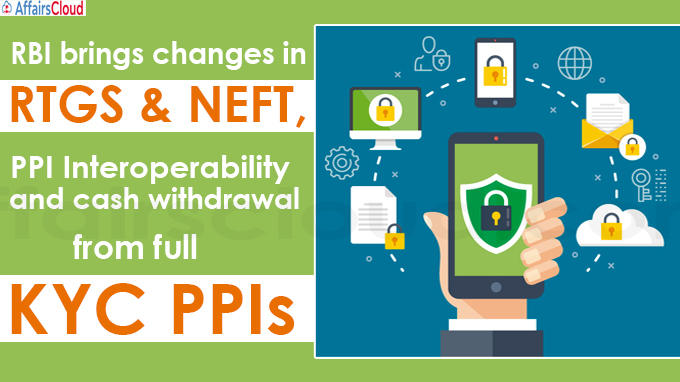 On April 7, 2021, the Reserve Bank of India (RBI) extended the membership of Centralised Payment Systems (CPSs) facilities such as National Electronic Funds Transfer (NEFT) and Real-Time Gross Settlement (RTGS) to non-bank payment system operators.
On April 7, 2021, the Reserve Bank of India (RBI) extended the membership of Centralised Payment Systems (CPSs) facilities such as National Electronic Funds Transfer (NEFT) and Real-Time Gross Settlement (RTGS) to non-bank payment system operators.
- Until now, only banks were allowed to use RTGS and NEFT payments facilities.
- Now, Prepaid Payment Instrument (PPI) issuers, card networks, White label ATM operators and Trade Receivables Discounting System (TReDS) platforms which are regulated by RBI can use NEFT and RTGS modes.
Objective: To minimise the settlement risk in the financial system and enhance the reach of digital financial services to all user segments.
About RTGS and NEFT:
- RTGS is a funds transfer system where it allows a continuous and real-time settlement of fund transfers, individually on a transaction by transaction basis (without netting).
- NEFT is a nationwide centralized payment system that allows the transfer of funds from one bank’s account to another.
RBI has doubled the Payments bank’s deposit limit to ₹2 lakhs to improve the Interoperability of PPIs to full-KYC
On April 7, 2021, RBI increased the existing maximum end of day balance (limit of funds that the account holders can keep until the end of the day) per customer of payment banks from Rs 1 lakh to Rs 2 lakh to support MSMEs, unorganised entities, other small businesses and to improve the interoperability of Prepaid Payment Instruments (PPIs) to full-KYC (Know Your Customer).
Background:
- On November 27, 2014 RBI has fixed the maximum end of day balance per customer for payment banks as Rs 1 lakh.
- Earlier most payments banks sweep-in, sweep-out the deposits with their partner banks if an individual’s end-of-day balance crossed the ₹1 lakh limit.
Key points on PPIs(Mobile Wallets) to full-KYC:
- RBI stated that the migration of PPIs (Mobile Wallets) to full-KYC was not significant (guidelines were given in October 2018) and hence it has hiked the limit of the outstanding balance in PPIs to Rs 2 lakh from Rs.1 Lakh.
- Cash withdrawal: Currently the cash withdrawal is allowed only for full-KYC PPIs issued by banks and the same facility is available through ATMs and PoS terminals.
- Now RBI allowed cash withdrawals from full KYC PPIs which are issued by non-bank entities
About Payment Banks:
- In January 2014 RBI gave guidelines to form Payment Banks to push financial inclusions based on Nachiket Mor committee recommendations.
- Payment Banks will be licensed under Section 22 of the Banking Regulation Act, 1949, and will be registered as a public limited company under the Companies Act, 2013.
- On April 11, 2016, Airtel Payments Bank became the first entity in India to receive a payments bank license RBI.
Guidelines of Payment Banks:
- These banks can operate current accounts and saving accounts. They can issue ATM or Debit cards, Net Banking and Mobile Banking facilities to their customers and they can also distribute non-risk financial products such as mutual funds and insurance.
- But, they don’t have the rights to provide lending services such as credit cards and loans facilities.
- The initial minimum capital requirement of ₹100 crores is mandatory for Payment banks
- The restricted deposits are currently updated to ₹2 lakhs per customer.
Recent Related News:
On January 5, 2021, the Reserve Bank of India (RBI) announced the introduction of a Legal Entity Identifier (LEI) for all payment transactions of Rs 50 crore and above undertaken by entities through Real Time Gross Settlement (RTGS) and National Electronic Funds Transfer (NEFT).
The National Payments Corporation of India (NPCI) has completed a private placement of 4.63% of its equity shares worth Rs 81.64 crores. This placement has enabled small finance and payment banks, as well as fintech to be its shareholders up to 0.44%.




